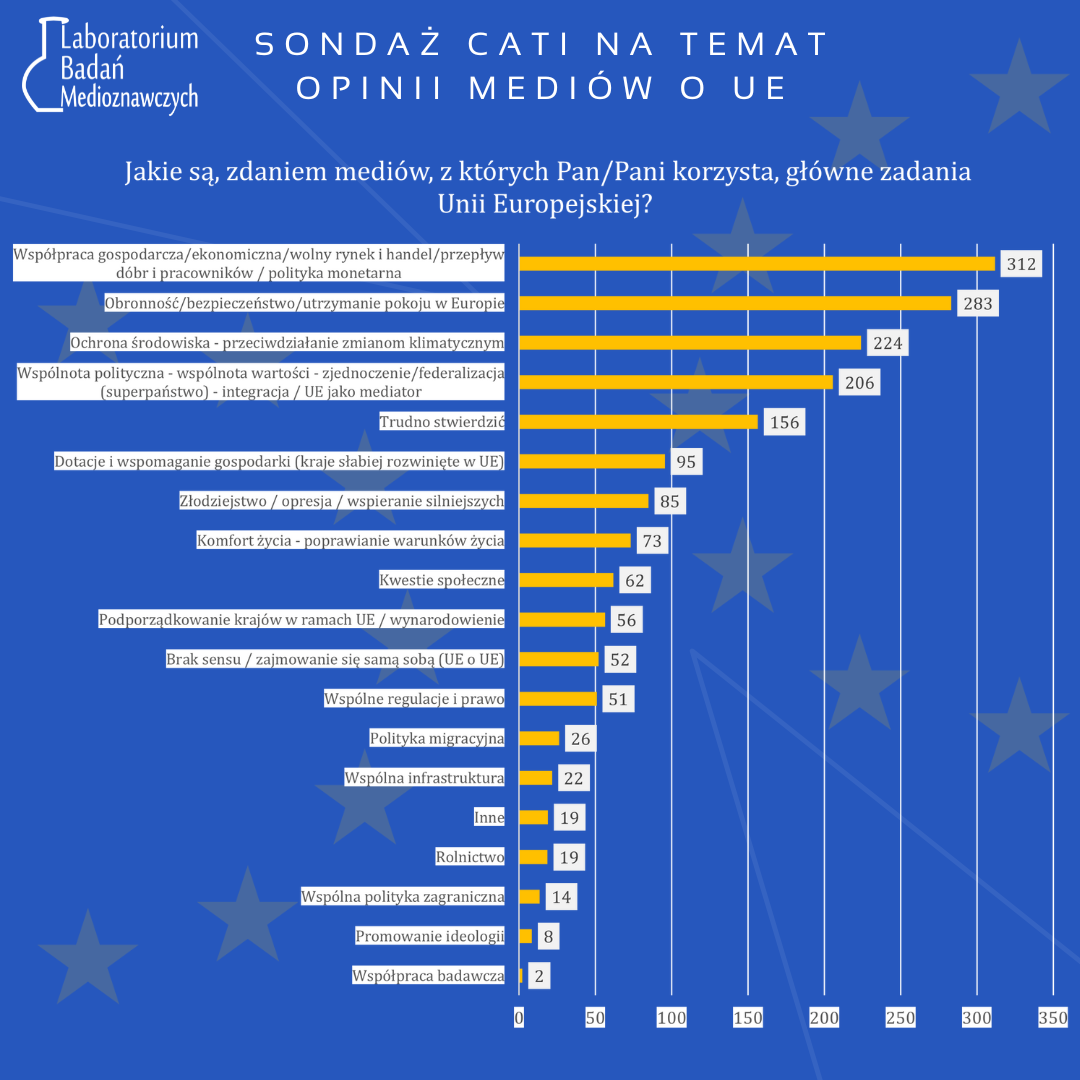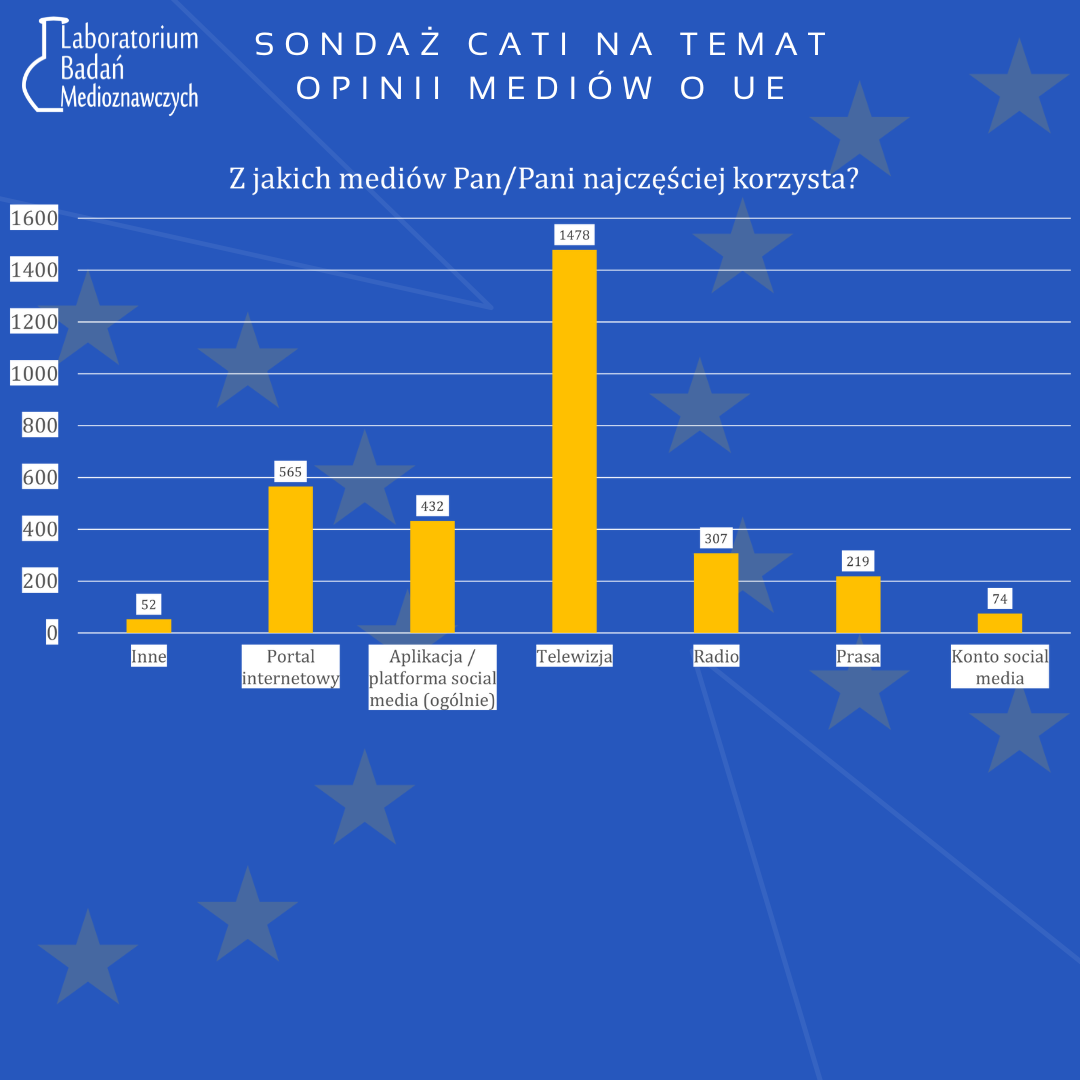 As promised, we are back with more results from our recent survey on media opinions about the EU.
As promised, we are back with more results from our recent survey on media opinions about the EU.
During the study, respondents were also asked what they believe the main tasks of the European Union are according to the media they use. In open-ended questions, respondents freely pointed out tasks of the EU, which were then grouped into 21 categories. These data indicate the broad way in which the media describe, in Poles' opinion, the tasks of the European Union. Respondents could list more than one task in their answers. Poles primarily mentioned economic cooperation, free market and trade, the movement of goods and workers, and monetary policy (the euro currency) - this accounted for over 18% of the responses. The second most cited task was defense, security, or maintaining peace in Europe (16%). Environmental protection - countering climate catastrophe (including the Green Deal) - came in third (13%). Fourth place was taken by political unity - a community of values (logic of unification/federalization - creating a superstate), further integration, and treating Brussels as a mediator within the EU. Finally, in fifth place, we have the category “Difficult to say.” This category included responses from those who had difficulty attributing any tasks to the European Union, from the perspective of the media discourse they follow.
This may indicate that one in ten Poles - media users - does not really know what the European Union is for or what they can expect from it. After 20 years of Poland's presence in the EU, this is quite a surprising observation. Of course, it is also important to mention the responses (a smaller percentage of indications) that largely question the essence of the European Union - in these categories, statements such as: theft, oppression, supporting the stronger, subjugating some countries to others, denationalization, dealing with itself (EU about EU), or promoting ideology appeared. Summing up these indications would give a result of up to 20% of total responses. Therefore, it seems that these responses are an expression of euroscepticism present in Polish society (but also in other EU countries, looking at the results of the last European Parliament elections) - concludes Prof. Anna Mierzecka, Laboratory of Media Studies, University of Warsaw.
Respondents participating in the study also indicated which media they use most often. The respondents' answers varied. In traditional means of communication, television is the dominant medium, while among new media, respondents most often mentioned online portals. The next place was taken by specific channels on YouTube. For online portals, Onet.pl and Wp.pl were most frequently mentioned. Interia.pl also made it to the podium (with a significant distance). Gazeta.pl and Oko.press were also mentioned. As for applications/social media portals – Facebook, YouTube, X (formerly Twitter), Instagram, and TikTok. In terms of radio, RMF FM dominated. The second place was taken by Tok FM, followed by the First and Second Program of Polish Radio and Antyradio. In the press category, Gazeta Wyborcza dominated, followed by weeklies Polityka, Newsweek, Angora, and Rzeczpospolita. When it came to accounts on social media platforms, Kanał Zero stood out.
During the study, our respondents were asked which media they use. Importantly, this was an open-ended question, where respondents could freely indicate the types of media as well as specific media brands they use to obtain current information. The vast majority of respondents (88%) answered by providing the names of specific media. The next two groups of respondents indicated a specific type of medium, without specifying the media brand (6%) or specific programs or individual channels on social media (5%). When classified by types of media, television clearly dominated (47% of responses), followed by online portals (18%) and specific applications and social media platforms (14%). These were primarily Facebook and Twitter/X. Other traditional media indicated by respondents served rather a complementary function to television and internet sources. Radio as a primary source of information was indicated in 10% of responses, while the press was indicated in 7%. Interestingly, a noticeable portion of respondents indicated personalized social media accounts linked to specific organizations or individuals as a source of information (just over 2% of responses).
The distribution of responses in this question indicates the still leading role of television as an informational medium, with a very strong position of internet sources in second place. The specificity of the responses in the study indicates that for older groups of recipients, television programs are the dominant form of obtaining information, while for younger groups, information portals and social media are preferred. Radio and the press serve a complementary function for both groups. A very interesting trend visible in the study is also the emergence of media brands operating exclusively on social media, which build their visibility and recognition through the use of charismatic personalities and in-depth analytical journalism - says Mgr Marcin Łączyński, Laboratory of Media Studies, University of Warsaw.

